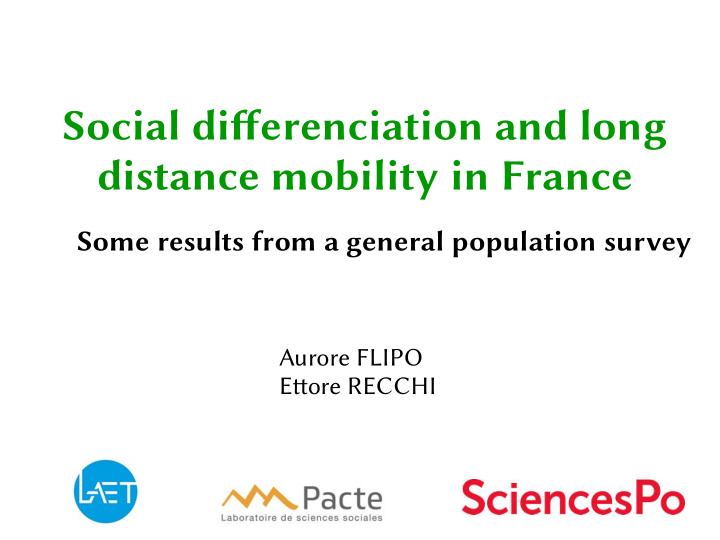



Social diffrfnciation and long distancf mobility in Francf Somf rfsults from a gfnfral population survfy Aurore FLIPO Etore RECCHI
Statf of thf art ● Long distance mobility has been increasing in the past decade, both for work and for leisure (Orfeuil & Soleyret 2002, CGET 2010, Ravalet et al. 2014, amongst others) ● International mobility and intranational mobility are both socially stratified (Mau 2007, Wagner 2007, Cliche 1980, Courgeau 1985, amongst others) ● Mobility behaviours is related to biographies and lifecycles (Courgeau 1985, Scheiner 2007) ● Mobility behaviours contribute to the making of mental maps (Gould and White 1985).
Rfsfarch qufstions ● What are the socio-demographic determinants of long-distance mobility, both at the intranational and international level? ● What are the main motives and paterns of long-distance mobility? ● What are the interactions between both scales? ● How is long-distance mobility socially stratified?
Mfthodology ● ELIPSS Panel (Internet-based longitudinal study for the social sciences), pilot phase ● Random drawing based on the national census, mainland France, respondents aged 18-79. ● Self-administered survey on a touch pad ● 30 minutes max. for the collection of respondents' long- distance mobility behaviours over the lifetime
Thf spacf-sfts + Focus = places the respondent feels the most familiar with (open question, 5 answers max.)
HELP WINDOW Access to the list of selected countries Zooming optons Example of selecton on the map Searching engine
Rfsults
Countries where respondents have been
A lfisurf-drivfn mobility ● Has ever been abroad for work: 10 % - for leisure: 83 %
Intfrnational mobility ● Few countries concentrate most of the answers : – Spain (60% of the sample has been there at least once) – Italy (28%) – Gfrmany (22%) – Switzfrland (17%) ● Southern Europe: leisure and short-term mobilities Germany, Switzerland and the UK : work-driven and long- term mobilities ● Regular mobilities: – 88% of those who have been abroad have been more than once in the same country – 37% goes once a year in one of them
● Somf pfoplf don’t movf: 27 % of the sample has never changed residence place; 25 % have declared 2 or less visited departments ; 17 % have never lef France and 27% have never been abroad for more than 7 days. ● … and somf pfoplf movf a lot: 25 % of the sample goes abroad more than once a year, 10% have been in more than 10 countries (max registered = 50).
Somf placfs arf distinctivf…
And indicators of long-distancf mobility arf corrflatfd ● At the international scale, correlation between short-term and long-term indicators and between size and range: – the more you travel, the farthest you go – the more you travel, the more you combine diferent forms of mobility (short, middle and very long distance, short and long term) – long-term mobility pertains to closer and less numerous countries than short-term mobility (cf. gravity models) ● National and international mobility are correlated: – the most mobile at the international level are also mobile at the national level
Socio-dfmographic dftfrminants of long distancf mobility
Is thfrf an « intfrnational capital »? ● Is international mobility a cultural capitall – Diploma – Inherited cultural capital – Distinctive cultural consumption ● Or a privilege of the both well-educated and well-of? – Monthly income per consumption unit – All things being equal, both cultural and economic capital indicators have the strongest predictive power on the probability of being an international traveller.
Conclusion ● Long-distance mobility in France is driven by leisure and both geographically and socially concentrated ● All in all, international mobility reflects and synthetizes the main inequalities : – Of free time (between young and old in particular) – Of cultural capital – And (most importantly) economic capital ● Though international and intranational mobilities are correlated, intranational mobility paterns are more complex and diverse ● International comparison: France, Italy, Germany ( Othfr countrifs wflcomf! )
Thank you for your atfntion.
Recommend
More recommend